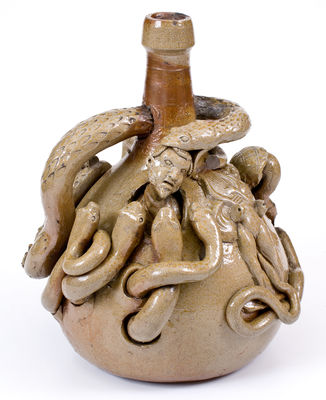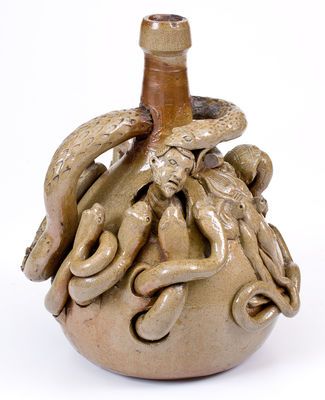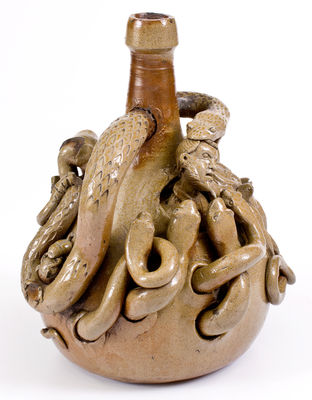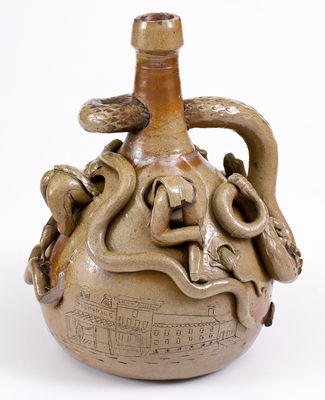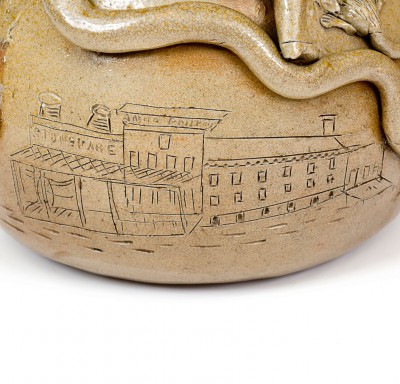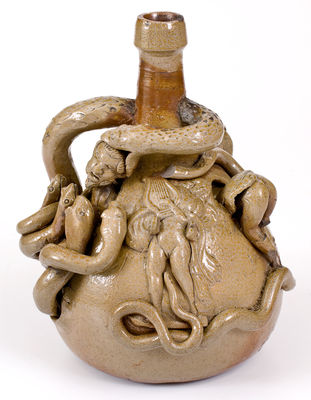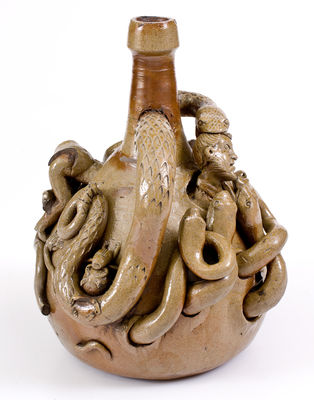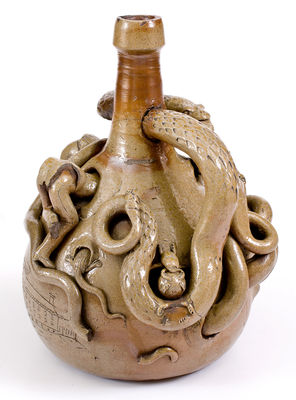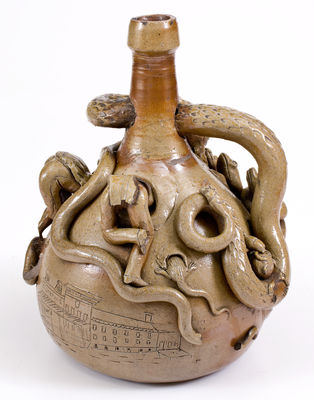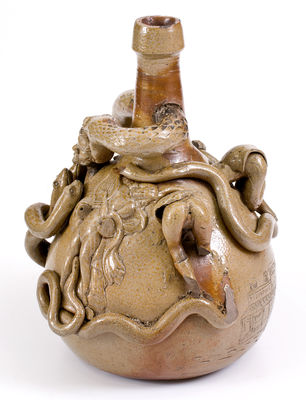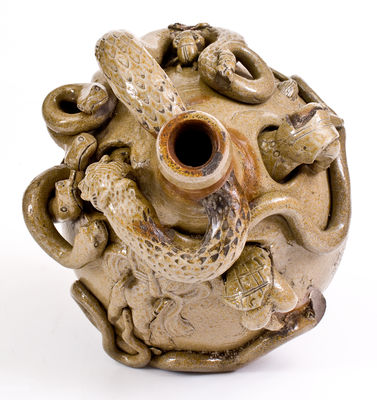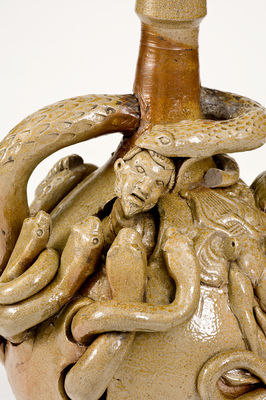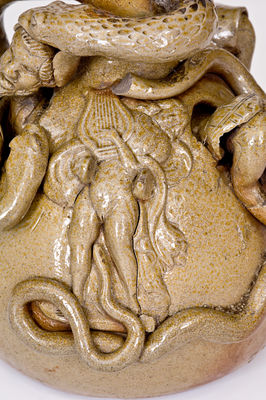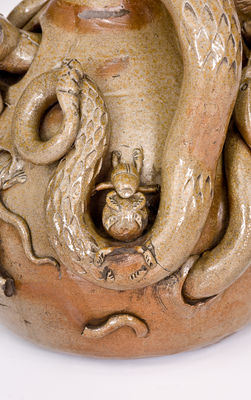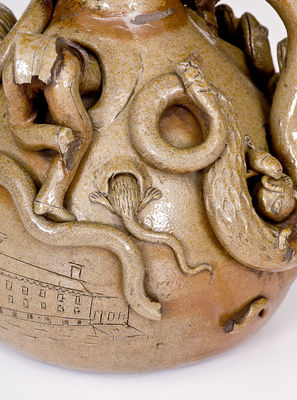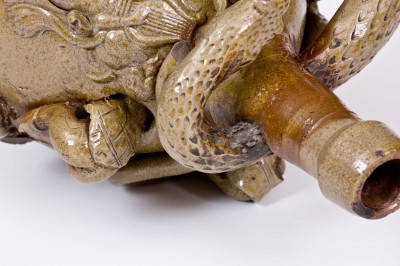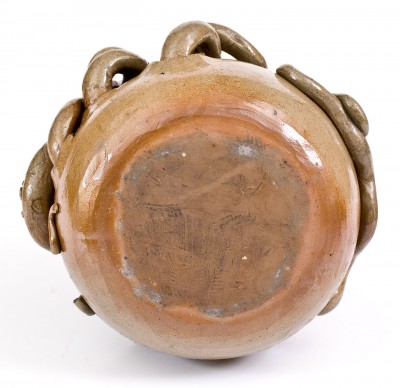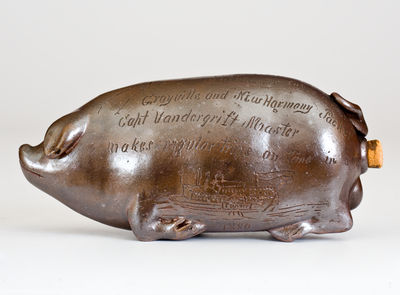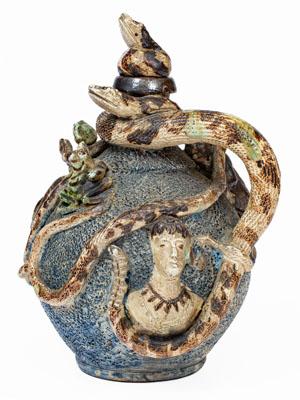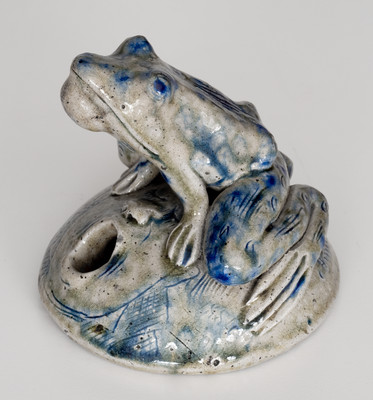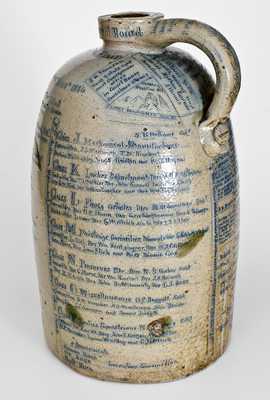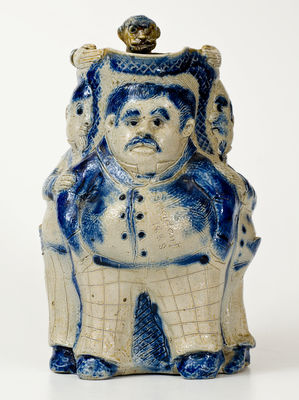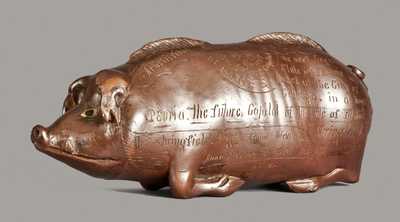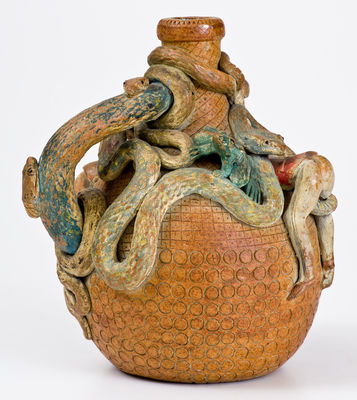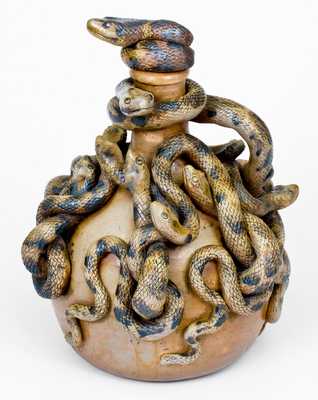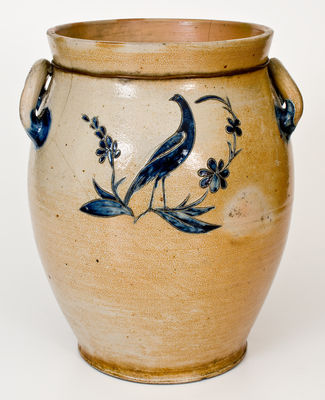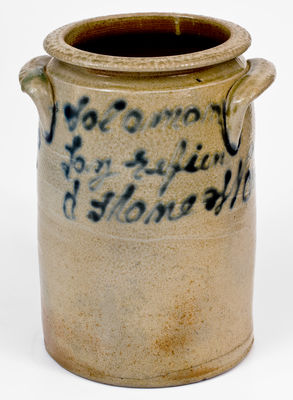Outstanding Salt-Glazed Stoneware Temperance Jug with Applied Figural Decoration and Incised Image of Anna Pottery, Wallace and Cornwall Kirkpatrick, Anna, IL, circa 1870-1880, wheel-thrown jug of highly-ovoid form with tall spout and tapered mouth, the surface decorated with hand-molded and sculpted clay figures. A large rattlesnake with incised and impressed scaling forms the jug's handle. Extending through the spout and making a dramatic turn, the snake is depicted with a wide, gaping mouth devouring, headfirst, a man trapped within the jug. The man's bust is depicted with superb detail with bent pose to the head as it is being consumed, the face displaying an open mouth, finely-sculpted nose, sideburns, goatee, and applied and incised hair. Circular coat buttons appear on the figure's chest, disappearing into the body of the jug. Below this central figure, four slithering snakes exiting the wall of the jug eagerly pursue the man in an attempt to participate in the meal. Executed with a sense of realism, one assumes a coiled stance, and a second crosses over the neck of another in an effort to reach the trapped man. To the right of the snakes is a large molded and applied figure of a nude siren playing a lyre, evocative of the seduction of alcohol. Two applied and pierced clay tabs at the siren's waist suggest she was fitted with a cloth dress that would flip up and expose the woman when the jug was tipped. Two other applied snakes flank the siren above and below. Further around the body of the vessel, two lower bodies of male figures extend from the wall of the jug, one with cross-hatched coat, wearing boots, the other wearing a jacket with stamped buttons and seam lines, featuring cross legs and wearing shoes. Further to the right, the rear end of a rat protrudes from the jug's wall, and a dung beetle rolling a ball of dung appears at the base of the jug's snake-form handle- both serving as metaphors for the depravity of alcohol consumption. Perhaps most intriguing about this work is its large design of Anna Pottery incised on one side. Featuring signs labeled "STONEWARE" and "ANNA POTTERY," the drawing includes two kiln chimneys, a covered porch, numerous windows, pierced roof molding, a fireplace chimney, and smaller porch. Few examples of Anna Pottery stoneware have survived with depictions of the pottery itself, this example made all-the-more important because of the iconic form it decorates. The large-sized snake jugs of Wallace and Cornwall Kirkpatrick are regarded as masterworks in the duo's oeuvre. These, along with their pig bottles, are their most famous creations and several of the former can be found in the nation's leading public and private ceramics and art collections. Relatively few of this size and grandeur are known. The form combines meaning, exemplary potting, and outlandish modeling, into pieces that make a strong visual and mental impact on the viewer. In the case of this jug and most others of its kind, the snakes are used as visual metaphors for the evils of alcohol consumption and its deceptive lure, the snakes representing the Devil as depicted in the biblical story of the Garden of Eden. The prolific use of snakes in the brothers' work is likely connected to Wallace's personal fascination with the animals. Period sources indicate he owned his own den of snakes and would even exhibit them at local fairs. Early representations of snakes on Kirkpatrick temperance jugs made circa 1865 appear more stylized; however, by the time this jug and several others were made, circa 1880, they had mastered the snakes' form, facial structure, and attitude. The realism with which the snakes are modeled and posed is possibly linked to the access these potter's had to living specimens in Wallace's personal collection. This jug, as with others of its style, features a stylish form atypical of American stoneware. Reminiscent of imported black glass onion bottles produced a century prior, the form features a base that was heavily-fettled during the leather-hard state, rounded off to an extent that the vessel is given a certain "lift," an appearance that it is almost floating. The modeling of the snakes and human figures, as discussed, showcases the Kirkpatricks' skill at mimicking life at a remarkable level, almost commensurate with that of academically-trained artists. (A clear difference in quality is evident between this work and others made by potters working under the Kirkpatricks, such as John L. Stone and members of the Bray family.) Using symbolism and an extremely high level of craftsmanship, this work is difficult to succinctly label, overlapping with a variety of artistic styles, movements, and genres. The methods of its manufacture and operation of its makers' as production potters creates an interesting dilemma, the jug seamlessly melding the utilitarian stoneware tradition with the ever-expanding American Art Pottery Movement of the late 19th century. Its form, prolific use of snakes, and rare image of the site where the jug was created, ranks this object among the finest examples of Kirkpatrick brothers stoneware that we have ever offered. The importance of this work is highlighted by its depiction in one of five color plates of Anna snake jugs, including perhaps the most famous examples, illusrtrated in Richard Mohr's well-known book on the subject. As noted by Mohr, "the brothers identified themselves closely with this jug. They signed it by incising on its side an image of the Anna Pottery building" (Mohr, p. 37). Literature: Illustrated in Mohr, Richard. Pottery, Politics, Art: George Ohr and the Brothers Kirkpatrick. Urbana and Chicago: University of Illinois Press, 2003, color plate 2 and p.37, figs. 21-22; discussed in Mohr pp. 36-37. Jug in damaged condition, often found with this form. Neck of jug reglued with some professional coloring where snake handle meets neck of jug. Crack in tail of snake handle and loss to rattle on end of snake handle. Minor chips to spout, one of which is glazed over. Painted touch-up or restoration to neck area of man's bust. Loss to leg and foot of one man going into the jug. Loss to tailcoat and foot of other man. Two smallest snakes with heads missing, one of which is also missing a 1 5/8" section of its tail. One dung beetle missing body. A tiny chip to pierced tab at waist of siren. H 10 1/2".

